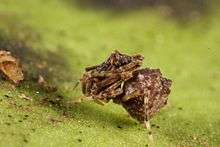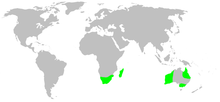Archaeidae
| Assassin spiders | |
|---|---|
 | |
| Austrarchaea sp. | |
| Scientific classification | |
| Kingdom: | Animalia |
| Phylum: | Arthropoda |
| Subphylum: | Chelicerata |
| Class: | Arachnida |
| Order: | Araneae |
| Infraorder: | Araneomorphae |
| Family: | Archaeidae C. L. Koch & Berendt, 1854[1] |
| Genera | |
|
See text. | |
| Diversity[2] | |
| 4 genera, about 70 species | |
 | |
The Archaeidae are a spider family with about 70 described species in four genera, as of October 2016.[2] Commonly known as assassin spiders, they are also known as pelican spiders, stemming from their specialised anatomy: they have elongated chelicerae (jaws) and necks for catching other spiders.
Assassin spiders
Spiders of the family Archaeidae are unusual in that they have "necks", which can be very long and slender, or short and fat. Archaeids prey only upon other spiders. Assassin spiders were first known from 40 million year old amber fossils which were found in Europe in the 1840s, and were not known to have living varieties until 1881, when the first living assassin spider was found in Madagascar. They are native to Australia, South Africa, and Madagascar, with the sister family Mecysmaucheniidae occurring in southern South America and New Zealand. They range in size from 2-8 mm.
The fossil record of this family was first identified from Baltic amber dating to the Eocene, although many taxa from these deposits have been reassigned to Mecysmaucheniidae, Pararchaeidae, and Holarchaeidae. Currently valid Baltic species include Archaea levigata and Archaea paradoxa. In 2003, Afarchaea grimaldii was described from Cretaceous Burmese amber aged between 88-95 million years, extending the record of this group considerably.
Taxonomy
The family Archaeidae was erected in 1854 by C. L. Koch and Berendt[1] for one genus, Archaea, initially with three extinct species,[3] all found in amber from the Baltic Sea or Bitterfeld in Saxony-Anhalt, Germany. No living species are placed in this genus.
Extant genera
As of October 2016, four extant genera are accepted by the World Spider Catalog:[1]
- Afrarchaea Forster & Platnick, 1984 – South Africa, Madagascar
- Austrarchaea Forster & Platnick, 1984 – Australia
- Eriauchenius O. Pickard-Cambridge, 1881 – Madagascar, South Africa
- Zephyrarchaea Rix & Harvey, 2012 – Australia
Fossils
Fossils found in amber, particularly from the Baltic and Myanmar (Burma), have been assigned to a number of extant and extinct genera placed in the family Archaeidae.[4] The extinct species Burmesarchaea grimaldii (syn. Afrarchaea grimaldii) was found in Burmese amber dated to 88–95 Mya.[5] Jurarchaea zherikhini Eskov, 1987 was previously considered a member of this family, but it is more likely a holarchaeid or a pararchaeid.
Phylogeny
A 2012 Bayesian phylogenetic analysis of 15 Archaeidae species, using combined molecular and morphological data, produced the cladogram shown below. Species representing modern genera found in Africa and Madagascar (Afrarchaea and Eriauchenius) were not resolved into monophyletic groups; Zephyrarchaea had not then been split off from Austrarchaea. The species found in European amber formed a clade, whereas Burmesarchaea grimaldii, from Burmese amber, appeared to be basal to modern genera.[6]
| Archaeidae |
| ||||||||||||||||||||||||||||||||||||
Distribution
Living species of Archaeidae occur in South Africa, Madagascar and Australia.
See also
References
- 1 2 3 "Family Archaeidae C. L. Koch & Berendt, 1854", World Spider Catalog, Natural History Museum Bern, retrieved 2016-10-13
- 1 2 "Currently valid spider genera and species", World Spider Catalog, Natural History Museum Bern, retrieved 2016-10-13
- ↑ Koch, C.L. & Berendt, G.C. (1854), "Die im Bernstein befindlichen Crustaceen, Myriapoden, Arachniden und Apteren der Vorwelt", in Berendt, G.C., Die im Bernstein befindlichen organischen Reste der Vorwelt [The organic remains of antiquity found in amber] (in German), 1 (2), Berlin, pp. 1–124
- ↑ Dunlop, J.A.; Penney, D. & Jekel, D. (2016), "A summary list of fossil spiders and their relatives, version 17.5" (PDF), World Spider Catalog, Natural History Museum Bern, retrieved 2016-10-13
- ↑ Penney, D. (2003), "Afrarchaea grimaldii, a new species of Archaeidae (Araneae) in Cretaceous Burmese amber" (PDF), Journal of Arachnology, 31: 122–130, retrieved 2016-10-13
- ↑ Wood, Hannah Marie; Griswold, Charles E. & Gillespie, Rosemary G. (2012), "Phylogenetic placement of pelican spiders (Archaeidae, Araneae), with insight into evolution of the "neck" and predatory behaviours of the superfamily Palpimanoidea", Cladistics, 28 (6): 598–626, doi:10.1111/j.1096-0031.2012.00411.x/full
External links
| Wikimedia Commons has media related to Archaeidae. |
| Wikispecies has information related to: Archaeidae |
- "Tiny Assassins" at California Academy of Sciences
- National Geographic Photo in the News: Bizarre Assassin Spiders Discovered in Madagascar
- Eriauchenius lavatenda page at California Academy of Sciences
- Eriauchenius vadoni page at California Academy of Sciences
- Palpimanoid Spiders: Archaeidae and Mecysmaucheniidae
- Wired 2014: Absurd Creature of the Week: The World’s Goofiest-Looking Spider Is Actually a Brutal Ninja